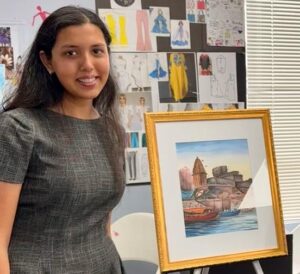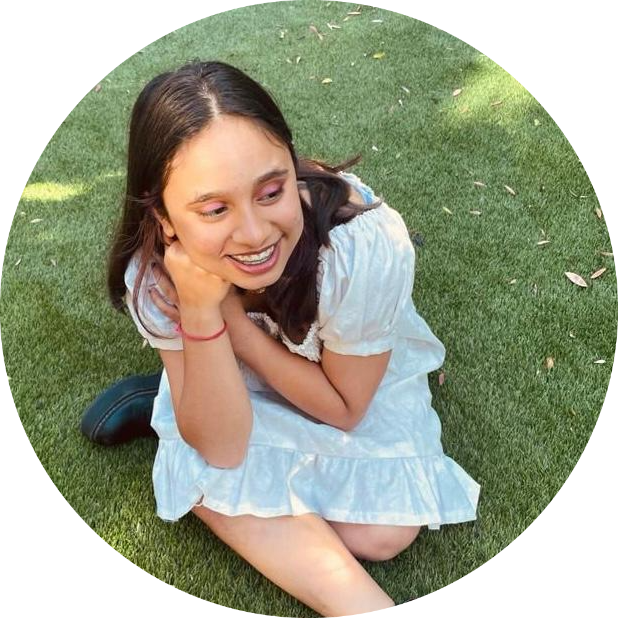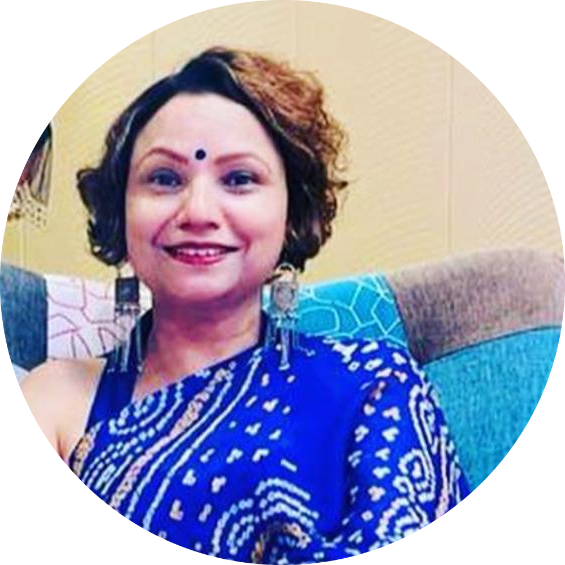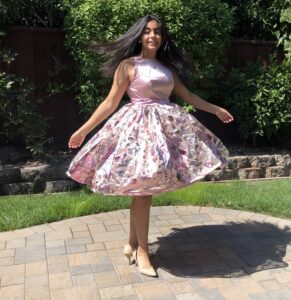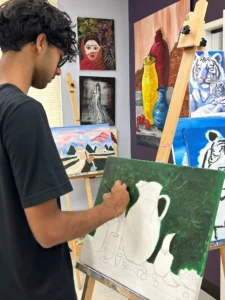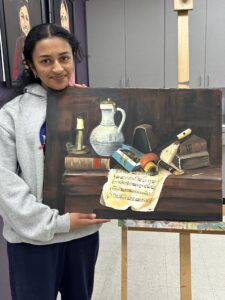Madhubani; Tradition Takes Flight
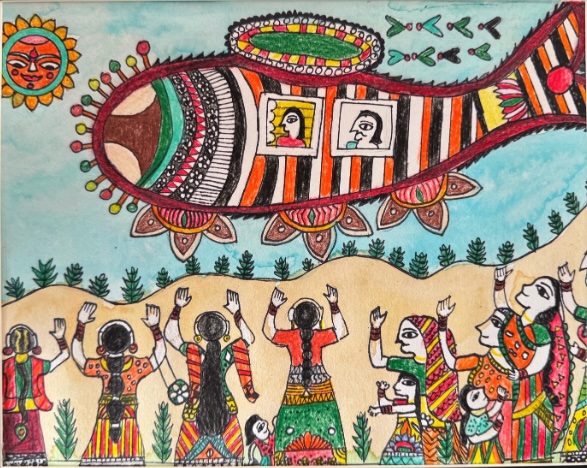
By: Pragna Gowdra Grade 8, Kalaa Studio A Journey Through Art: The Flying Fish of Imagination Created at Kalaa Studio, this artwork feels like a glimpse into a magical world, where tradition and fantasy come together. At the heart of the piece is a giant, flying fish-shaped vehicle, soaring through the sky with two people peering out from its windows. The fish is decorated with bright stripes and intricate patterns, outlined in bold black lines that make every detail pop. The vibrant colors—orange, green, and yellow—bring the scene to life, bursting with energy and excitement. Inspired by Madhubani art, a traditional Indian folk style known for its flat, colorful designs and natural plant-based dyes, this piece captures the essence of cultural storytelling. There’s no shading, just bold, two-dimensional patterns, much like illustrations in a book. For me, this artwork is about adventure and imagination. In Madhubani art, fish symbolize good luck and life, but here, the fish flies, representing the thrill of exploring new places. Below, a group of villagers dressed in traditional Indian attire stand with their hands raised—perhaps waving goodbye or cheering with excitement. A smiling sun with a human face watches over them, adding warmth and connection to the scene. This piece tells a story of a village coming together, either to send off loved ones or to share a message with their leaders. It blends heritage with fantasy, showing that even the most traditional stories can take flight in new and unexpected ways. #ArtAtKalaaStudio #MadhubaniArt #FlyingFish #FolkArtMagic #ImaginationInArt #KalaArtAndDesign
Fashion-Transcending a Fabric Between Generations
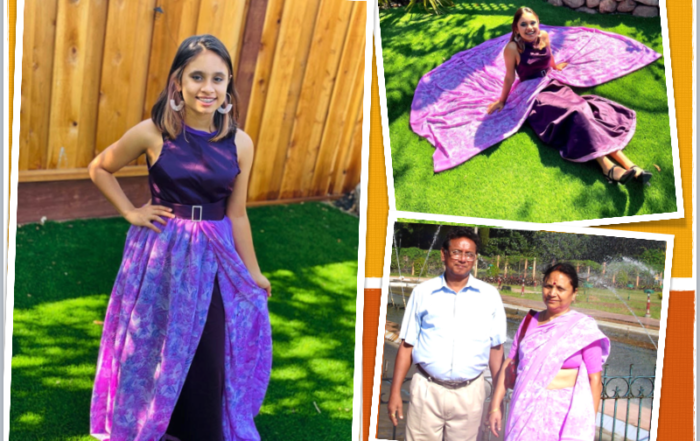
By- Saesha Sharda, Sophomore, 2021 My grandmother, Nani, had a beautiful saari: a purple one with floral patterns all over. Nani was amazing at dress-making and knitting. As far as I can remember, I have been wearing her hand-knitted sweaters and hand-me-downs. So, I decided to transform her purple saree into a formal designer dress/piece. With my mother’s help, I picked a deep wine-purple satin fabric to go with it and designed a simple ‘A‘-line under-dress with a raglan sleeve cut. With the saree fabric, I gathered it and created a wrap-around belt/skirt with gemmed buckle. This way, the under-dress + wrap-around skirt had the versatility to be tied anywhere, from the waist to even the shoulders. After countless sewing machine runs, weeks of time, mistakes, and redo the dress was complete. Wearing it, it feels as if I am embodying a purple butterfly. It was eye-opening to transform the fabric from one style to another and essentially pass it from one generation to another. The fabric had a distinct smell, a smell that reminded me of my Nani and my grandparent’s home in Dehradun. I remember her warm smile, gentle laugh, and beautiful aura by simply smelling that fabric. It is just a reminder that the saari, though it is nonliving, lived through my grandmother’s life and now it will live through mine; and this applies to any item of clothing. By using that purple flower-patterned fabric, I feel as if I am honoring her by honing her dressmaking skills and continuing her legacy.
Happiness is… Having Hot Pot
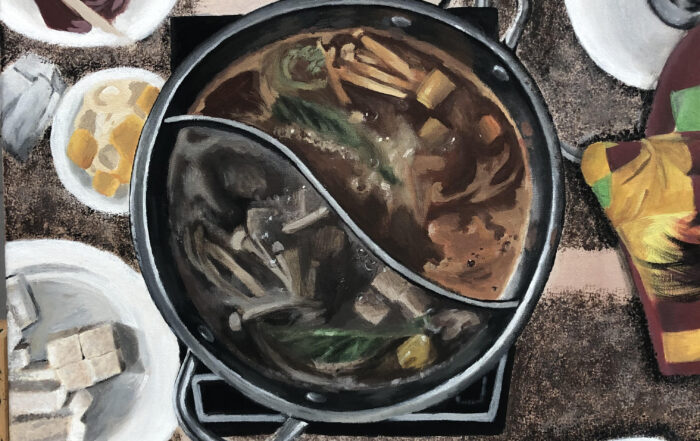
By- Vivian Gao, Senior 2023 Food has always brought people together, and my family is no exception. Family meals provide an opportunity for family members to come together, strengthen ties and build better relationships. In our busy lives being together with family for food is really important, as old tradition used to be. In my acrylic painting, the composition is centered around the pot, reflective of how it brings my family together and gives us a chance to take a moment from our busy lives to enjoy each other’s company. Hot pot is a well-known Chinese dish, and we eat it for special occasions and holidays; it’s our version of a Thanksgiving turkey. For this painting, I have used the acrylic painting technique of layering. The beauty of acrylic paint is that it dries fairly fast (unlike oil paint). This means that you can paint a layer of acrylic on the canvas, wait for it to dry, then paint another layer over top. This method gave depth and richness to my detailed food painting. The project was Still life with a combination of observational drawings. For this I prepare the meal laid the table and planned my artwork. I’m so happy with the outcome. Instances like this become memories I recall fondly, and paintings like this show my appreciation for the opportunities I have to spend time with the people I love. I hope the viewer is filled with warmth or a newfound appreciation for the little moments in their life.
COVID Hang Back-2.5 years, One painting

By Aditi Manchanda- 2022 This is the story of my journey with one painting over 2 years. When I first started this piece, I was in 7th grade. Once I found out we were doing a still-life concept, I excitedly drew out what I wanted to paint. A big silver jug on a book, some fruit, and a quill in an ink pot. I kept painting every week with the intention of displaying my painting at the next Kalaa Exhibition. Little did I know at the time, the exhibition was not even going to take place. One fateful day in In March 2020, the school closed. At the time, we were told it would only be for a week but the break never ended. A couple of weeks later, art classes were switched online. For the next two years, I sketched watercolor painting and tried a bunch of other fun crafts all through a screen. Eventually, I forgot about my painting that lay in the art studio, incomplete for two entire years. When I finally returned to the studio in 2022, I was ecstatic. At the time, my interests had shifted from art and painting to fashion design. I wanted to make my own clothes and accessories which is what I ended up doing for a couple of months. Then, my teacher showedme my painting from when I was in middle school and I was bewildered at my choices. I was nothappy with what my 12-year-old self had picked. I found my selection amusing, my techniques were less refined than now, nevertheless completed a few left-out strokes and finished the work as I always feel the completion of the task is equally important With time, not only had my skills improved but have varied dimensions in the creative arena I thought completing it as quitting on anything is not the right choice to make. It was a selection right for a 12-year-old me and it was interesting to, let me finish that incomplete task which unfortunately COVID has taken away from all of us. In the end, I decided to stick with my painting as a reminder of how much growing up changed me.
Changing Our Wiring
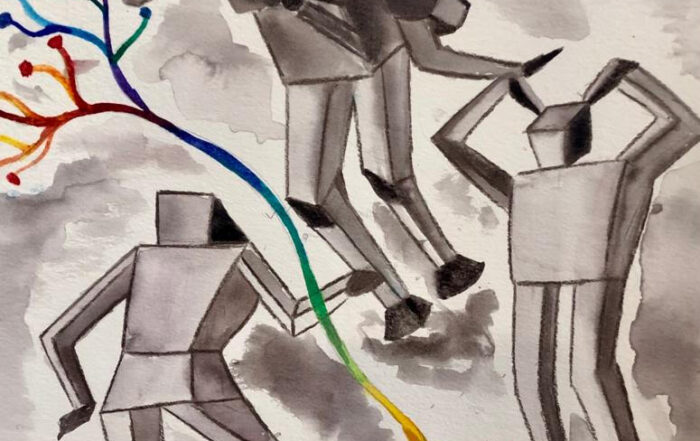
By Saesha Sharda, Sophomore, 27 November 2021 Humanity does not have a lack of struggles, and nowadays chaos is dissociating into different parties, groups, and movements. Sometimes, it is important to take a step back and think about the basic things required to clear the chaos, and that is exactly what my artwork focuses on. I made this artwork for the Reflections Art contest 2021 for which I was awarded Merit of excellence. This art was an abstract representation of my thoughts. I chose watercolors and handmade paper as a medium. In my artwork, there are 4 beings shown in a setting of chaos. There are two beings pictured in the middle arguing, causing a ruckus. Being at the top, however, is productive and carries a friend across the crisis. Also pictured in the artwork is a neuron. The way neurons communicate is by passing on a message from the ends of the neuron, called axons. The arguing beings are not near the axons and therefore are not able to receive the message that is being relayed. Therefore, they are arguing, causing even more spread of confusion and chaos. The beings at the top, however, can receive that knowledge and are able to channel their love and empathy towards helping those who are struggling in the crisis. My artwork shows that the passage out of the crisis is through human compassion and that the ignorance of information does the opposite. Take for example the battle for LGBTQ+ rights around the world. Countless studies have shown that being queer is not a choice and that individuals in the LGBTQ+ community do not deserve to be discriminated against. This aspect represents the logical component. We can also listen to and learn from the experiences of LGBTQ+ individuals and empathize with their struggles. This aspect represents the empathetic component. Bigots who despise individuals of the LGBTQ+ community ignore the information, which leads to assumptions and the spreading of hate. We must clear the chaos by collectively looking at information and empathizing with others; We must change our wiring.
Importance of Art Education for Young Brains
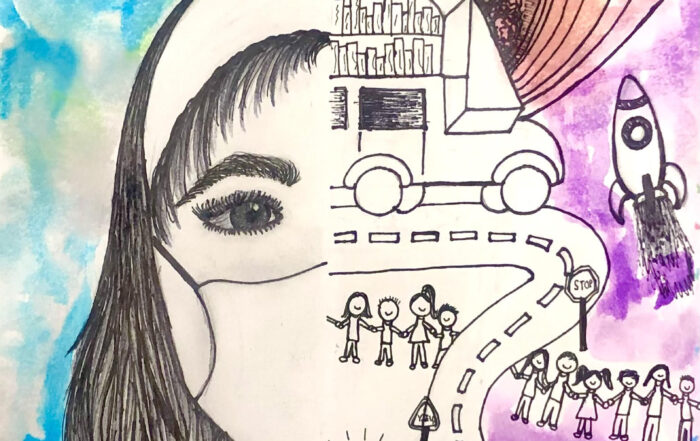
By- Saanvi Sharma, 8th Grade “Creativity is contagious. Pass it on.” -Albert Einstein. One of the greatest mathematicians in history has thought of creativity and art as so important, that he passed on this quote for generations to ponder. Creativity is usually hidden beneath all other worries and stress that people face, but with the power of art, that creativity can be and will be taken to a whole other level. Art can be anything from poems to painting, but every form of art has its benefits. And art courses are most significant in these moments, as students’ minds are still developing and finding ways to cope with situations. Arts education is of great importance and benefits students’ emotional, academic, and social performance. The education of arts is a requisite in sustaining emotional stability. My current art piece is about headspace inspired by Rabindra Nath Tagore. According to UF, “A literature review from Frontiers in Psychology outlined several studies linking aesthetic experiences with broad improvements in subjects’ emotional states that promote physical and psychological well-being.” The author points out that not only does art benefits students in creativity areas, but also supports emotional status. Also, according to another enhanced study by UF “Encouraging students to use their imagination can help them actively engage with new concepts and discover connections between ideas as well as provide advantages for their social and emotional well-being.” This shows that art may not seem like something that links to and helps with mental health, yet research clearly shows it in fact does! Not only does Art, benefit people emotionally, but it also affects them socially as well. Technology has affected this generation greatly, leading to addiction, depression, and more. Communicating to and from students through art will help them slowly come back onto the right path. According to HazeldenBettyFord, “Sleep disorders can develop as teens stay up all night to play with technology, and as a result, academic, athletic, and social performance can suffer…In-person social skills may deteriorate.” Performance in most areas start lowering as people start finding distractions that lead to all sorts of other problems, but luckily there is always a solution…engaging students in art and creative activities lessens stress and encourages students to interact socially. Another study by UF to reason with my recent claims.. shows that “Giving learners the time, space, and materials for creative expression can lower stress, improve memory, and make them feel more socially connected.” Moving on to the third gain arts education provides: boosting the level of student’s performance academically. According to researchers from the Johns Hopkins University School of Education, instruction becomes more effective when educators integrate creative activities and make them central to academic development. Across disciplines, including STEM, there’s room to reimagine classes with a strong emphasis on drawing, painting, playing music, performing drama, and other creative pursuits. This shows that including fun and engaging activities creates an environment for students such as yourselves, to willingly participate and learn, while enjoying themselves as well. The Department of Katy Independent School District says, “The fine arts enhance perceptual and cognitive skills. The Burton study of more than 2000 children found that those in the arts curriculum were far superior in creative thinking, self-concept, problem-solving, self-expression, risk-taking, and cooperation than those who were not (Burton et al., 1999).” This exemplifies the need for art courses. Many students may not know how much self-expression can impact them, but when they do express themselves, whether it be through sketching or playing a musical instrument…this tool results in a sense of accomplishment. In other words, pride. Creative outcome pushes students more in other academic courses as well, allowing boosts in grades, self-confidence, and much more to occur. The education of arts has a significant impact on student’s academic performance, social interaction, and emotional wellbeing. Art is an important aspect in almost everything, whether it be just expressing your feelings in a healthy way, or creating a career path with it. Either way, art goes a long way and not many people know the real impact of it, but I’ll tell you from experience, it’s an amazing aid just to even make you feel better on your worst days. Furthermore, as we know how crucial the study of arts is, especially in honing the brains of young students at an early age…spread the word, creativity is contagious. So It is beneficial in all aspects to incorporate art into everyday lives.
My Tween Brush Strokes-The Golden Gate Bridge
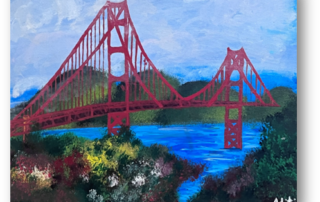
By- Aditi Manchanda, Sophomore 2022 This painting is of the Golden Gate Bridge and is one of my oldest paintings. I made it when I was in 6th grade. It has so many memories associated with it that I thought to document them in my art blog; “Better late than never :)’I don’t remember much of that time but I do remember the many skills I learned from this painting. It was the basis for all the paintings I have made since then. I learned many valuable painting techniques such as how to use shading in an image to make something look 3d, dabbing the paintbrush to make flowers and bushes, how to paint water realistically, and how to make clouds. These are skills that I have used in several of my paintings since then and have improved at. I really enjoyed making this painting and I put a lot of hard work into it. I also want to talk about the significance of this painting. Living in the bay area has given me the luxury of visiting the Golden Gate Bridge. So many of my favorite memories were made there, hiking, walking across the bridge, visiting Golden Gate Beach, and Golden Gate Park. I have been there so many times with so many different family members and friends that sometimes I forget that people travel from all over the world just to see it. It is a beauty that I take for granted and it attracts over 10 million people a year from all over the world. I never really processed that I lived near a historical world-famous landmark. This painting is a reminder of all the fun times I have had in my life with the people I love but more importantly, it is a reminder to never take things for granted.
Why do I Matter, coz I believe
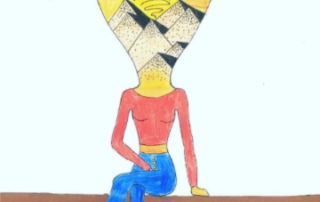
By- Aditi Manchanda, Grade 8 This is my artwork from the Virtual Reflections Art Competition that was held during the month of October. The theme for this contest was “Why do I Matter”. The first thing that I did was make the head into a light bulb. This is the main portion of the focus of the topic “Why do I Matter”. I matter because I want to grow up and share my ideas with the world to make it a better place. This part of my art represents my ideas. One idea that I would like to spread awareness about equality. There are so many people in this world who get discriminated against because of the color of their skin, or their religion, or even because of their gender. They don’t get many opportunities that others do just because of their appearance or what they believe in. Because of all of this commotion, there are so many innocent people who get harmed. There is so much violence, protesting, and war especially with all the riots and chaos in 2020. This is why inside of the light bulb I wrote the word peace and made some scenery around it. I chose to make this piece because I love to draw fashion figures and wanted to incorporate that into my artwork. I made this figure sitting down with a red top and blue jeans. This part of my art represents me. I used colored pencils and a black pen (to trace) to complete my artwork. If used by themselves, colored pencils are used in two techniques – layering and burnishing. Layering is a technique usually used at the beginning of the drawing. Its idea is to use primary colors in layers and with that to get different tones. Burnishing is done on layers and for that is used a colorless blender or a light-colored pencil. For my artwork I used layering. I used this technique for the background in my light bulb. I just used one layer of color for the skin, clothes, and the mountains of my picture. Finally, I used brown paint to make the ledge that my figure is sitting on. The paint I used was acrylic. I hope that this was informative and encouraged you to support causes to make the world a better place. Thank you! — Aditi Manchanda Grade 8
Mumma Bear;Shading Techniques
By Saira Siraj, 7th Grade The first artwork (of the two that I will be talking about) that we did is a shading techniques page. Here we have 4 different ways to shade in a drawing, shading, scumbling, stippling, and hatching. I first made a 16by16 grid towards the bottom of the page. Then we drew two long rectangles, on the top of the page. In the first one, we made lines inside, making equal parts. Then we shaded the rectangle from lightest to darkest. Then below that, we made the same scale but as a gradient, this time with no partitions. In the 16by16 grid on the bottom half of the page, we made columns of different shapes, spheres, cubes, cylinders, and cones. We shaded each row with a different technique. Hatching, Scumbling, Stippling, and Shading. Scumbling was the easiest as it was like scribbling and Stippling took the longest because you have to be very careful with the dots and make sure they don’t look like lines. Hatching, Scumbling, and even Cross Hatching, all are similar because, to make the value darker, you need to make the lines/scribbles closer together to show the tightness. Our next artwork was a drawing of a mama bear and a baby bear. We were allowed to use any techniques that we wished, so I decided to do shading, as it would not take up as much time and I could still get a good-looking drawing. I started off by sketching the two bears. Then, we shaded the cave and the crevices of the bears really dark.
Journey of my comic art
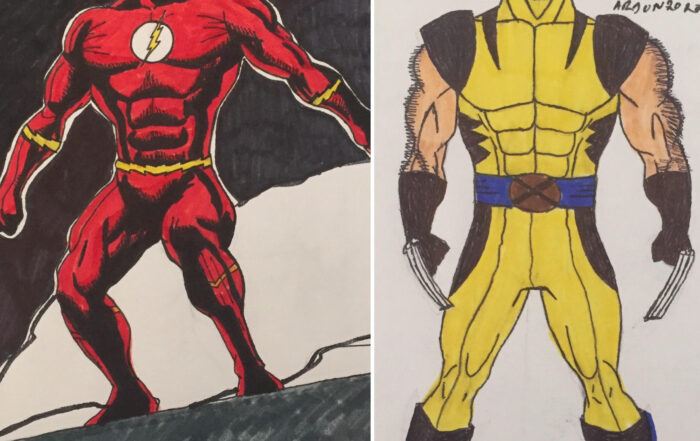
By Arjun Anand 8th grade As a kid, I liked to watch superhero movies like The Avengers and Justice League. I liked seeing the superheroes fly around and run faster than the speed of light. These movies started my love for superheroes, which has continued to this day. As I grew up, I started reading comic books related to superheroes. I saw the amazing art in these books and wanted to draw like that. I started learning to sketch the human anatomy and draw features. Now, that love has evolved into a skill I’m very proud of. Comic books and comic art started in June 1938, when Joe Shuster and Jerry Siegel had the idea to create a comic book about a man who could fly, shoot lasers, and wore a blue and red spandex suit. Thus, Superman was born! This influenced many artists and writers to create their own superheroes, which has evolved into one of the biggest industries in the world. When I first started drawing, I used to mess up with the anatomy of a body a lot. I would accidentally leave a lot of components out or mess up a crucial part of the drawing. Now, when I draw, I know where to draw what. This can be shown in the drawings I have attached. The first drawing, which is The Wolverine from Marvel comics, is very substandard. It has minimal detail and no shading at all. The second drawing, which is The Flash from DC comics, has more details, looks more refined, and has a background, which makes it look a lot better. The second drawing is one that I’m very proud of, but I hope to improve my skills. For the first drawing, I pencilled the basic sketch. Then I used a black 0.1 inking pen to ink the drawing. Then I used markers to color the rest. As for the second drawing, it took a longer time and had a more complex process. As usual I pencilled the bsic sketch, the lightly drew in the details and features. Then, I used a black 0.4 inking pen to ink the basic pencils. Next, I went back and lightly shaded the drawing with a pencil, just to make sure I did the shading correctly. Then I inked the shading. Finally I colored in the entire drawing using markers and used a black marker to fill the background.

